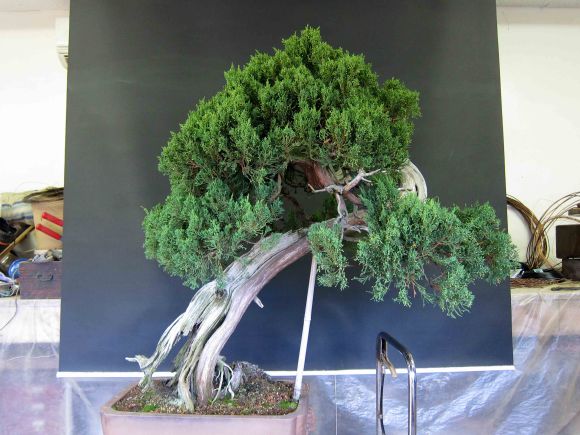Now that I’m all settled back in Japan, I can get back to work and get some more posts on the blog. If you didn’t already know, I spend most of September back in the US taking a bit of time off and working with the wonderful Bonsai people of Milwaukee. Once I got back to Japan, I was put right back to work wiring trees and wiring trees and wiring trees… sigh.. you get the point. 😉 I’d have to admit that after a long break, it took me some time to get back into the mode of things here but it’s been two weeks now and my body is has already gotten use to being in a constant state of aches and pains. Haha! Today is my first day off since coming back so I thought it was be a good time to get some writing done. I got tons of stuff backlogged that are just waiting to be organized and posted, so some good stuff to come!
As I looked through my photos on what to write about today, I decided to start strong and show what I did on this particular customer’s Shimpaku in the last week. It’s pretty tall as you can see from the picture above and quite bushy. The work on this tree actually started in August and the styling happened in October. There’s a reason for that and I’m going to break it down here and show you what we did. Perhaps you can apply these same techniques to your Shimpakus at home. The Summer and Fall are a great time to work on Junipers so still a couple of months before Winter is in full swing.
Cleaning and Some Cutting
The first thing I normally do when working on a Juniper is cleaning. So what is cleaning? Basically, removing old foliage, yellow/brown foliage and dead branches. It can also involve eliminating small unwanted branches that we know we won’t use. If I’m not sure, I’ll always hold off the cutting until I start styling the tree.
Once the cleaning is done, it give us a clearer picture of what the tree has to offer. This way, we don’t accidentally cut off branches we may need. I didn’t get too many shots of the tree while I was cleaning, but I did cut some branches off another Shimpaku that I’m going to use to illustrate what I did on the big one.
First off, I removed any brown needles. No pictures here because it’s so straight forward. I normally use a combination of my hands and tweezers to remove the loose brown and yellow needles. They should just come right off when touched. Old juniper foliage will brown out and fall off ever year on the interior of the branches so it’s perfectly normally to see that happening. Think of old needles falling a pine tree. If the tips of the foliage are browning out, then there’s a problem.
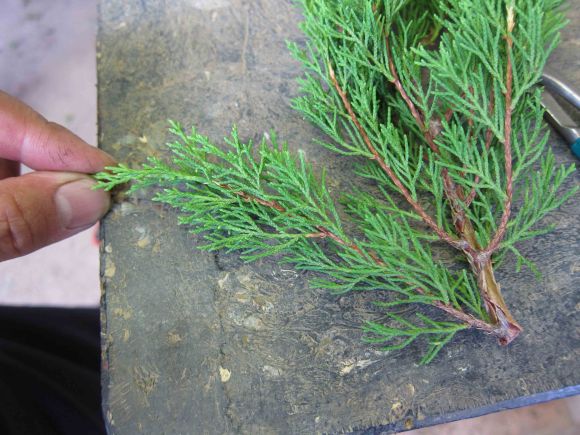 Here’s an example of a new branch growing off the side of a main branch. Say we want to use this branch to help make our pad. On the inner branch structure of trees, there should only be wood. Green foliage is normally located on the tip of branches only. If I used this branch as is, the structure would look either un-natural of an old tree or make the tree look young.
Here’s an example of a new branch growing off the side of a main branch. Say we want to use this branch to help make our pad. On the inner branch structure of trees, there should only be wood. Green foliage is normally located on the tip of branches only. If I used this branch as is, the structure would look either un-natural of an old tree or make the tree look young.
 I would either lightly pull or cut off the foliage at the base of the branch. Now the branch looks more like a branch. I would continue doing this on the rest of the tree.
I would either lightly pull or cut off the foliage at the base of the branch. Now the branch looks more like a branch. I would continue doing this on the rest of the tree.
But! If I wanted to make the branch shorter, I would leave the green at the base and cut the terminal end off.
 Here is a shot of the underside of a large Sierra juniper canopy I took years ago. Note how the foliage is only on the tips of the branches? That’s what we want to show in our Bonsai as well.
Here is a shot of the underside of a large Sierra juniper canopy I took years ago. Note how the foliage is only on the tips of the branches? That’s what we want to show in our Bonsai as well.
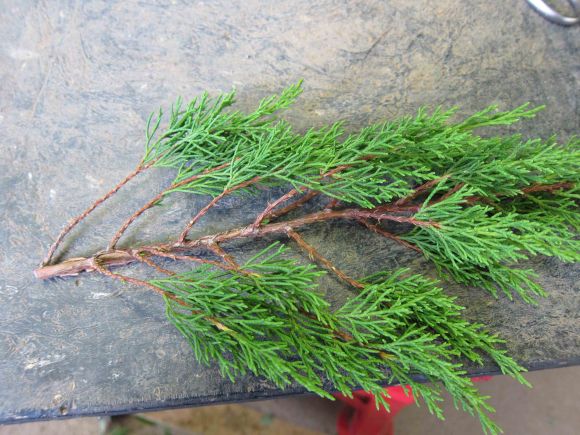 So here is an example of a branch where I cleaned out all the interior growths to show off more of the brown branch structure. I also cut off any branches that are hanging down. For the most part, I keep the side branches and some of the up growing branches. Cleaning out the interior old or weak foliage is done every year on Junipers so that more light can get through to the interior and lower areas of the tree to keep branches healthy.
So here is an example of a branch where I cleaned out all the interior growths to show off more of the brown branch structure. I also cut off any branches that are hanging down. For the most part, I keep the side branches and some of the up growing branches. Cleaning out the interior old or weak foliage is done every year on Junipers so that more light can get through to the interior and lower areas of the tree to keep branches healthy.
 Lets say that the branch is too long and I want to develop a new terminal end. Now is a time I can cut the terminal end off and pick a new leader. By doing this, we also help develop taper in the branches (refer back to the Sierra canopy to see natural taper). So now it’s not just about length and having lots of branches, we need to have taper as well. Cutting back is how we achieve that in Bonsai.
Lets say that the branch is too long and I want to develop a new terminal end. Now is a time I can cut the terminal end off and pick a new leader. By doing this, we also help develop taper in the branches (refer back to the Sierra canopy to see natural taper). So now it’s not just about length and having lots of branches, we need to have taper as well. Cutting back is how we achieve that in Bonsai.
Cutting Back
 Here is another branch where I cleaned out the inside to expose the brown branching. Next I’ll look for any branches that will cause too much congestion in the pad.
Here is another branch where I cleaned out the inside to expose the brown branching. Next I’ll look for any branches that will cause too much congestion in the pad.
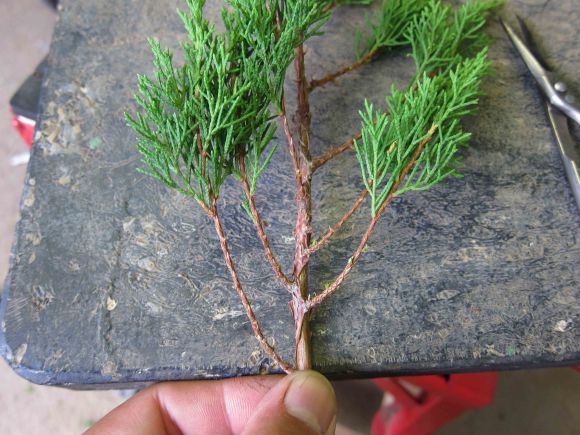 Note the one branch I removed? Now the branch before and after have more room to develop. The branches should be spaced apart so each of them have plenty of room to grow and develop. Branches tend to have a natural spacing between them because they are always searching for the light. That’s why for the most part, you don’t see branches touching each other on a tree (I think there are laws against that actually ;)).
Note the one branch I removed? Now the branch before and after have more room to develop. The branches should be spaced apart so each of them have plenty of room to grow and develop. Branches tend to have a natural spacing between them because they are always searching for the light. That’s why for the most part, you don’t see branches touching each other on a tree (I think there are laws against that actually ;)).
 Again, another example if I needed to make the branch shorter. Here I cut of the terminal end and will replace it with the next small branch. Since the taper transition is so sudden from large to small, I would need to grow out the small branch to thicken it, then cut it again to develop even more taper.
Again, another example if I needed to make the branch shorter. Here I cut of the terminal end and will replace it with the next small branch. Since the taper transition is so sudden from large to small, I would need to grow out the small branch to thicken it, then cut it again to develop even more taper.
 Now if you have a lot of time on your hands, you don’t necessarily have to wait till green foliage become brown branches before selecting the ones you want for the future. This technique takes more time but will focus the energy of the tree into branches that you want to develop. Take this young branch for example. It’s one branch with a lot of young side green branches that have yet to really extend. We can go in and selectively remove future branches, now.
Now if you have a lot of time on your hands, you don’t necessarily have to wait till green foliage become brown branches before selecting the ones you want for the future. This technique takes more time but will focus the energy of the tree into branches that you want to develop. Take this young branch for example. It’s one branch with a lot of young side green branches that have yet to really extend. We can go in and selectively remove future branches, now.
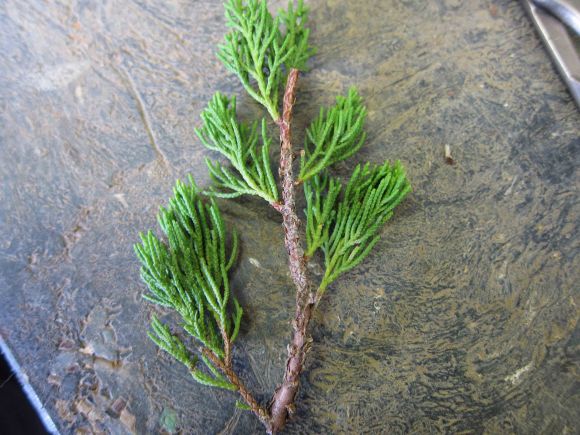 Here we removed some of the green branches. Now that some of the competition is gone, these kept branches will start to extend faster than if we left all the green.
Here we removed some of the green branches. Now that some of the competition is gone, these kept branches will start to extend faster than if we left all the green.
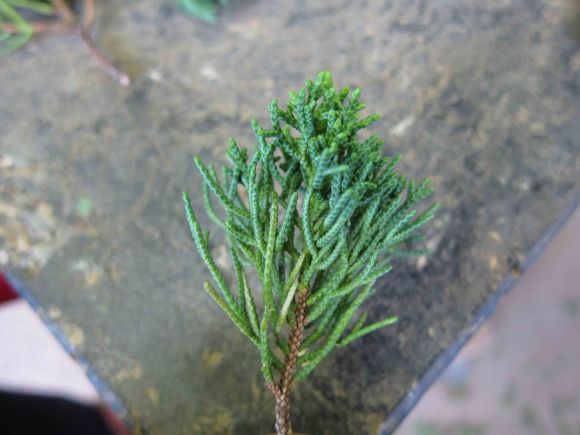 In the last two examples, we were cutting back large branches. How about the green foliage ends? These areas we can be cut too to promote more finer and denser branch structures at the tips of the tree. First we need to recognize the strong and weak areas of the branch tips before we start cutting. This will prevent us from cutting too much and getting an undesirable effect.
In the last two examples, we were cutting back large branches. How about the green foliage ends? These areas we can be cut too to promote more finer and denser branch structures at the tips of the tree. First we need to recognize the strong and weak areas of the branch tips before we start cutting. This will prevent us from cutting too much and getting an undesirable effect.
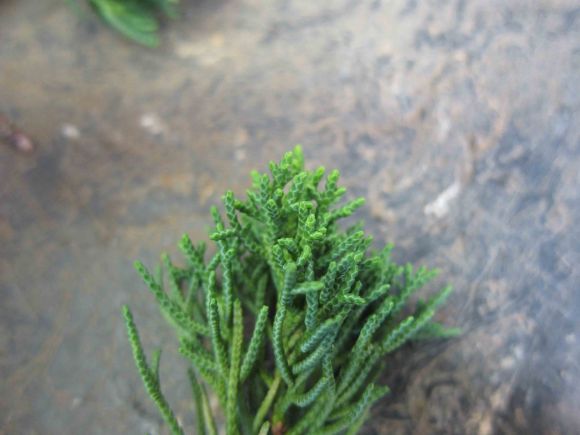 The stronger part are the tips. Note how dense the ends are and that each tip is pushing new growth.
The stronger part are the tips. Note how dense the ends are and that each tip is pushing new growth.
 The weaker parts are the foliage lower in the branch. Note how they are longer and leggy with no density. The tips that are growing tend to be slow whereas the tips that are not growing will end up being yellow/brown foliage we’re cleaning next year.
The weaker parts are the foliage lower in the branch. Note how they are longer and leggy with no density. The tips that are growing tend to be slow whereas the tips that are not growing will end up being yellow/brown foliage we’re cleaning next year.
 So what do you think will happen when we cut the foliage back to weak foliage? In this case, the foliage will weaken significantly and start to push out juvenile growth (needle like foliage). If needle foliage appears, the tree would have to be left alone till mature growth starts to appear again. We could potentially lose years of grow and development now because we have to wait for the tree to get health again. If the area isn’t strong enough to even push juvenile growth, the branch will die back to the next strong area. This is an example of cutting too much off.
So what do you think will happen when we cut the foliage back to weak foliage? In this case, the foliage will weaken significantly and start to push out juvenile growth (needle like foliage). If needle foliage appears, the tree would have to be left alone till mature growth starts to appear again. We could potentially lose years of grow and development now because we have to wait for the tree to get health again. If the area isn’t strong enough to even push juvenile growth, the branch will die back to the next strong area. This is an example of cutting too much off.
 Here’s another example of a healthy strong growth tip.
Here’s another example of a healthy strong growth tip.
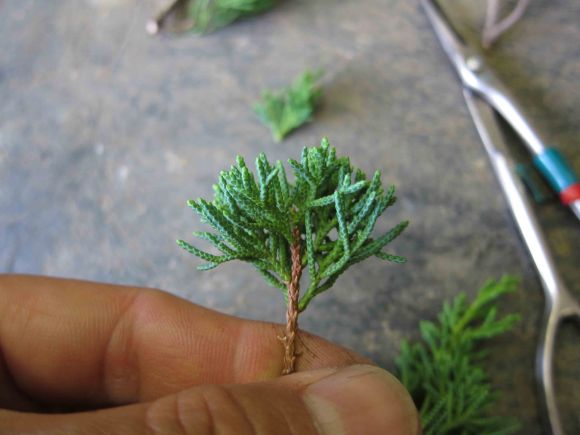 Here’s the same foliage tip with the terminal end cut off. Note how there are still plenty of strong side foliage left. In this case, the side strong foliage will continue to grow into more branches (long-term) or denser foliage tips (short-term). This is an example of the safe way of cutting foliage back and keeping the tree healthy.
Here’s the same foliage tip with the terminal end cut off. Note how there are still plenty of strong side foliage left. In this case, the side strong foliage will continue to grow into more branches (long-term) or denser foliage tips (short-term). This is an example of the safe way of cutting foliage back and keeping the tree healthy.
Now To The Tree
 Here is what the tree looks like after we cleaned and cut back some of the running tips.
Here is what the tree looks like after we cleaned and cut back some of the running tips.
 The tree was wired 4-5 years ago and a lot of it was biting into the branch at this point. One night, the customer (Mr. Ota) came by and helped us remove the wire. That was nice of him 🙂
The tree was wired 4-5 years ago and a lot of it was biting into the branch at this point. One night, the customer (Mr. Ota) came by and helped us remove the wire. That was nice of him 🙂
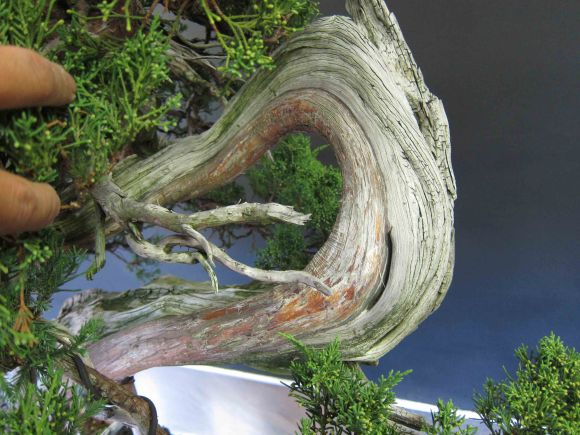 The best portion of the tree was this natural bend in the trunk. This is going to be on area that we’ll need to show off when the tree is styled. Once the cleaning cutting and de-wiring was done, we put the tree back out on the bench to allow it to rest till it gets rewired. This was around the end of August.
The best portion of the tree was this natural bend in the trunk. This is going to be on area that we’ll need to show off when the tree is styled. Once the cleaning cutting and de-wiring was done, we put the tree back out on the bench to allow it to rest till it gets rewired. This was around the end of August.
October
 Here is the tree again in the beginning of October. The tips pushed slightly and I could tell the tree was much happier. I’m sure the tree appreciated the extra fertilizer cakes we layered down for the month.
Here is the tree again in the beginning of October. The tips pushed slightly and I could tell the tree was much happier. I’m sure the tree appreciated the extra fertilizer cakes we layered down for the month.
About Wire Marks on Junipers
 Many times, we always hear about how bad it is to have wire scars and for the most part, it is true. In Junipers though, we can get away with it for several reasons. 1. The tree callus over wire scars very quickly (this scar filled in within the month of October and the 8 gauge wire was almost flush with the branch surface). 2. It can help hold the branch in position faster because of the way the wood forms around the callus. 3. When almost fully healed it gives the branches character and interest instead of a smooth round branch. It actually makes the branches look older.
Many times, we always hear about how bad it is to have wire scars and for the most part, it is true. In Junipers though, we can get away with it for several reasons. 1. The tree callus over wire scars very quickly (this scar filled in within the month of October and the 8 gauge wire was almost flush with the branch surface). 2. It can help hold the branch in position faster because of the way the wood forms around the callus. 3. When almost fully healed it gives the branches character and interest instead of a smooth round branch. It actually makes the branches look older.
So the next time the wire is biting in a little on your juniper, don’t worry too much about it. Many professionals here in Japan actually want it to happen.
Of course, by now, I don’t have to mention that there is a point where it’s overkill so don’t let the tree eat the wire either. 😉
 So after half a day of cleaning the trunk and two days wiring, we were finished. We didn’t do anything too drastic to the tree other than use the branches we had and created pads. We cut off a few branches here and there but all minor stuff. Large pads on the bottom of the tree and smaller pads as we moved up to the apex. One of these days, I’ll focus on some post about wiring and more on pad development.
So after half a day of cleaning the trunk and two days wiring, we were finished. We didn’t do anything too drastic to the tree other than use the branches we had and created pads. We cut off a few branches here and there but all minor stuff. Large pads on the bottom of the tree and smaller pads as we moved up to the apex. One of these days, I’ll focus on some post about wiring and more on pad development.
The main adjustment Mr. Tanaka had for me was that I needed to pull the main branch back a bit more because it was coming too forward. Other than that, he seemed okay with my work. When I wired the tree, I tried not to show any guy wires or large glaring wires on thick branches.
 Here’s a shot from underneath one side of the tree.
Here’s a shot from underneath one side of the tree.
 A shot from the top. Nice round pads going out in all directions (towards the light).
A shot from the top. Nice round pads going out in all directions (towards the light).
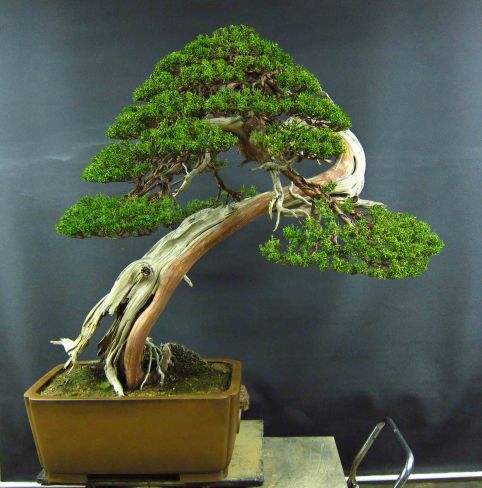 Here’s a shot of the tree at night. Not to say that this is a better picture, but look how different the tree looks and feels in different lighting. We’re planing on showing the tree at The Nagoya Castle show this month (outside) and at Meifu-ten in January (inside). In November or so, all the trees for Meifu-ten will be professionally photographed so it would be interesting to see how the tree looks under some really good lighting as well.
Here’s a shot of the tree at night. Not to say that this is a better picture, but look how different the tree looks and feels in different lighting. We’re planing on showing the tree at The Nagoya Castle show this month (outside) and at Meifu-ten in January (inside). In November or so, all the trees for Meifu-ten will be professionally photographed so it would be interesting to see how the tree looks under some really good lighting as well.
Some Thoughts on the Tree
Overall, I’m happy with how the tree came out. I hope that Mr. Ota is happy with the tree as well. Since the tree is going into two shows in the coming months, there wasn’t too much I could change. To be quite honest about it, the first thing I wanted to do with this tree was to graft roots right at the base of the big curve on the trunk and make it into a medium size tree. The curve is the most interesting feature on the tree and a lot of the movement is in the top half. The bottom portion of the trunk, though large and old, is fairly uninteresting to look at. Left like this, this tree will always be in the shadows of the big great junipers out there, whereas if this tree was smaller with all that tight movement, it has the potential of being great (think trunk first!). Also, the tree would be much lighter which is nice too 😉
Mr. Ota has been hesitant of the big change in the past but has decided that after the two upcoming shows, he’s going to allow us to do the grafts and significantly change the whole tree. I can’t wait to get that going and I’ll be sure to have my camera ready!
Many Thanks!
Thanks for reading everybody and I hope I you were able to take something away from this post. If there is anything I might have missed or you have questions about, please feel free to comment and I’ll be on top of the answer. Take care!
———————————————————————————————-
I think by know you’ve all come to realize that I’m a big fan of pottery and ceramics in Bonsai. Check out this post written by my good friends Sam and KJ Edge about their research and translation of an old poem painted on a porcelain pot by Tsukinowa Yusen. Yusen is the most famous porcelain pot painter in Bonsai and his art is highly prized and collected. Just knowing the story behind those words, makes this pot so much more meaningful and cherished. WOW! Here is a preview of the pot they’re talking about and a link as well. Enjoy!
Tsukinowa Yusen, In Search of an Answer
—————————————————————————————————-
P.S. If you are actively reading this blog, I would appreciate it if you subscribe to it (right column of the blog). This is one of the best ways for me to know how many people are reading. Thanks!
